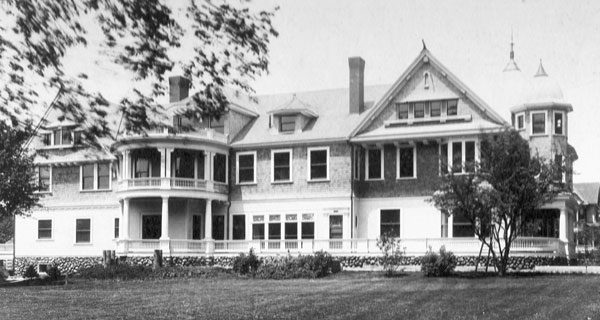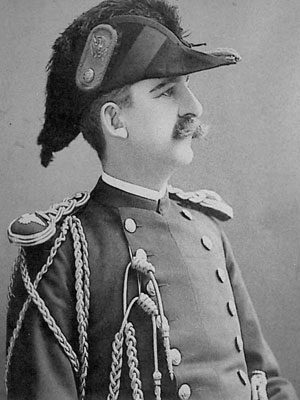[ccfic caption-text format="plaintext"]
One Hundred Years Later, the Colonel Remembered
He died 100 years ago and Medfield had never seen anyone like him before and will probably never see anyone quite like him again. He was the closest thing Medfield has ever had to a czar. As owner of the hat factory, the number-one employer in the town and the second largest hat factory in the United States, all social, economic and political life in Medfield revolved around him. If you did not work in his hat factory, then your business was probably tied to it in some way. (The hat factory was located where the Montrose School is located today on North Street.) He also owned the Elm Tree Inn on North Street, a poultry farm on Dale Street, a lumber business, a grist mill, acres of real estate, and numerous boarding houses for his workers. His birthday was even a local holiday, with all hat factory workers given the day off with free passes to the Brockton Fair to celebrate.
His name was Edwin Vinald Mitchell.
Today, only Mitchell Street, Mitchell Court, and Vinald Road still retain his name, giving us a reminder of the power of Colonel Mitchell, who reigned here from the end of the 1880s to his death in 1917, 100 years ago.
At the time, the politics of Medfield were the politics of the Colonel. He was a staunch Republican, except in one interesting case when he apparently shifted to support Democratic Governor William Russell (1891-1894), who subsequently appointed him to the board of trustees for the planning and building of the Medfield Insane Asylum (later renamed Medfield State Hospital). Mitchell also served on Republican Governor John Q.A. Brackett’s staff (1890-1891) and was an elected member of the Governor’s Council. He received the title “Colonel” from service in these state offices.
Mitchell was reportedly born in Sangerville, Maine. He arrived in Medfield penniless from Westboro, where he had learned the manufacturing end of the hat trade and, in a Horatio Alger type of story, soon became the most powerful person in town. Mitchell’s start was helped by the fact that he married Blanche Curtis, whose father was part owner of the hat factory. He was then appointed plant manager and upon the death of Daniel D. Curtis, joined in partnership with the New York sales connection of brothers-in-law Haskell Searle and Granville Dailey. Mitchell fit well into the mold of the new industrialists who were making their mark across the American landscape. Like many American industrialists, Mitchell dictated terms to his workers, who were often fired and generally forced to leave town if they went against his wishes.
Industrialists like Mitchell used their power and unity to support political candidates, whom they believed best fit their needs and wishes. In Medfield, support for the Republican candidates meant the hat factory support as well. During the election of William McKinley in 1896, the McKinley banner was raised over the hat factory, and a torchlight parade for McKinley featured floats by the hat factory and a fireworks display from Mitchell’s mansion (site of today’s post office on North Street).
His mansion was a house like no other Medfield had ever seen; a mansion of seismic proportions. Its destruction in 1961, in a war-like assault by a 24-ton M-19A Army tank, is an event likely never to be repeated. Col. Mitchell’s Manor, later known as the Manor Inn, was remodeled in 1898, at the sensational cost for those days of $90,000. He named the mansion “Akkompoin” — the brother of Massasoit, who had welcomed the Pilgrims to Plymouth. It became the town showcase, containing 32 rooms. It had a library with a huge fireplace and mahogany paneling, a music room and a large dining room. On the second floor were 11 bedrooms. The third floor, like the first, was built as a scene of splendor. Here was the combined playroom and ballroom. Inlaid on the floor of this arena, which could hold up to 800 people, were designs for hopscotch, checkers and backgammon. In later years, this ballroom was the site of many Medfield wedding receptions. Originally, the property extended back to Vinald Road. The grounds of the meticulously landscaped lot included a tennis court, carriage sheds, and a barn.
Mitchell was very generous with his money and donations to the town. The town reports of the time sing high praise for the Colonel; indeed his money and generosity were of benefit to the town. But so, too, in many cases, was that generosity also of benefit to Mitchell himself. Those elected to town office in Medfield usually had the approval of Col. Mitchell.
At the time, Catholics in general and Italians and Irish in particular did not share any of Medfield’s political pie. The Italians, centered around Frairy Street, did form a political voting bloc, led by Angel Belmont, who acted like a political “ward boss” to deliver the Italian vote. But they were no match for Col. Mitchell and the town’s established “Yankees.” While Town Meeting had broad powers and membership, it was usually passive. Medfield’s real political power was found in the creation of a town oligarchy that was controlled by Colonel Mitchell.
Colonel Mitchell retired from active work in 1910, leaving his two sons, Granville Curtis Mitchell and Edwin Searle Mitchell, to run the hat factory administration. Suffering from stomach trouble, he died 100 years ago, at the age of 66, and was buried in Vine Lake Cemetery; the site today of the tallest monument in the cemetery.










